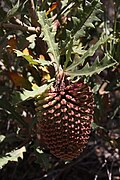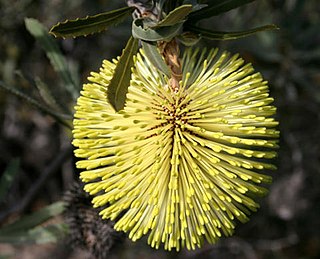
Banksia rosserae is a recently described species of Banksia. Endemic to inland Western Australia, it is the only Banksia species to occur solely within the arid zone.

Banksia petiolaris is a rare species of flowering plant in the family Proteaceae native to Western Australia, where it is found in sandy soils in the south coastal regions from Munglinup east to Israelite Bay. It was first described by Victorian state botanist Ferdinand von Mueller in 1864, and no subspecies are recognised. B. petiolaris is one of several closely related species that will all grow as prostrate shrubs, with horizontal stems and thick, leathery upright leaves. Those of this species can be viable for up to 13 years—the longest-lived of any flowering plant recorded. It bears yellow cylindrical flower spikes, known as inflorescences, up to 16 cm high in spring. As the spikes age, they turn grey and develop up to 20 woody seed pods, known as follicles, each.

Banksia aculeata, commonly known as prickly banksia, is a species of plant of the family Proteaceae native to the Stirling Range in the southwest of Western Australia. A shrub up to 2 m (7 ft) tall, it has dense foliage and leaves with very prickly serrated margins. Its unusual pinkish, pendent (hanging) flower spikes, known as inflorescences, are generally hidden in the foliage and appear during the early summer. Although it was collected by the naturalist James Drummond in the 1840s, Banksia aculeata was not formally described until 1981, by Alex George in his monograph of the genus.
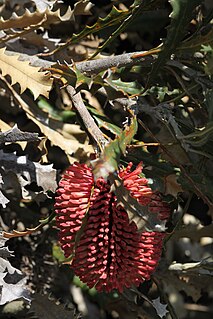
Banksia caleyi, commonly known as Caley's banksia or red lantern banksia, is a species of woody shrub of the family Proteaceae native to Western Australia. It generally grows as a dense shrub up to 2 m (7 ft) tall, has serrated leaves and red, pendent (hanging) inflorescences which are generally hidden in the foliage. First described by Scottish naturalist Robert Brown in 1830, Banksia caleyi was named in honour of the English botanist George Caley. No subspecies are recognised. It is one of three or four related species with hanging inflorescences, which is an unusual feature within the genus.

Banksia elderiana, commonly known as the swordfish banksia, is a species of shrub in the plant genus Banksia. It is a tangled, bushy shrub with stiff, serrated leaves and spikes of yellow flowers. It occurs in two disjunct areas in the Goldfields-Esperance region of Western Australia. One population extends over a large area from west of Kalgoorlie south to Ravensthorpe, with another population in the Great Victoria Desert north of the Queen Victoria Spring.

Banksia lemanniana, the yellow lantern banksia or Lemann's banksia, is a species of flowering plant in the family Proteaceae, native to Western Australia. It generally grows as an open woody shrub or small tree to 5 m (16 ft) high, with stiff serrated leaves and unusual hanging inflorescences. Flowering occurs over summer, the greenish buds developing into oval flower spikes before turning grey and developing the characteristic large woody follicles. It occurs within and just east of the Fitzgerald River National Park on the southern coast of the state. B. lemanniana is killed by bushfire and regenerates from seed.

Banksia lindleyana, commonly known as the porcupine banksia, is a species of woody shrub in the genus Banksia of the family Proteaceae. It generally grows as a small shrub to 1 m (3 ft) high with long narrow serrated leaves, and bright yellow oval or round inflorescences. Flowering occurs in late summer, after which time the flower spikes age and turn to brown and then grey, and develop up to 70 follicles. It occurs in the vicinity of Kalbarri, Western Australia. Found on sandy soils, the plant serves as a pollinator for a variety of bird and animal species.

Banksia repens, the creeping banksia, is a species of shrub in the plant genus Banksia. It occurs on the south coast of Western Australia from D'Entrecasteaux National Park in the west to Mount Ragged in the east.

Banksia sect. Banksia is one of four sections of Banksia subgenus Banksia. It contains those species of subgenus Banksia with straight or sometimes curved but not hooked styles. These species all have cylindrical inflorescences and usually exhibit a bottom-up sequence of flower anthesis. It is a widely distributed section, with taxa occurring in both the south west and east coastal distributions of the genus.

Banksia ser. Abietinae is a valid botanic name for a series of Banksia. First published by Carl Meissner in 1856, the name has had three circumscriptions.

Banksia epica is a shrub that grows on the south coast of Western Australia. A spreading bush with wedge-shaped serrated leaves and large creamy-yellow flower spikes, it grows up to 3½ metres (11½ ft) high. It is known only from two isolated populations in the remote southeast of the state, near the western edge of the Great Australian Bight. Both populations occur among coastal heath on cliff-top dunes of siliceous sand.
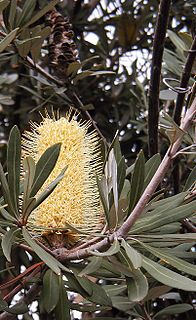
Banksia ser. Salicinae is a valid botanic name for a series of Banksia. First published by Carl Meissner in 1856, the name has had three circumscriptions.
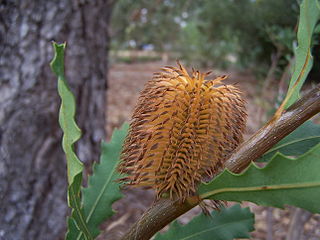
Banksia ser. Quercinae is a valid botanic name for a series of Banksia. First published by Carl Meissner in 1856, the name has had three circumscriptions.

Banksia ser. Cyrtostylis is a taxonomic series within the plant genus Banksia. First published at sectional rank by George Bentham in 1870, it was demoted to a series by Alex George in 1981. The name has had three circumscriptions.

Banksia ser. Prostratae is a taxonomic series in the genus Banksia, a genus of iconic Australian wildflowers. It consists of six closely related species in section Banksia, all endemic to Western Australia, with a prostrate habit.

Banksia ser. Crocinae is a taxonomic series in the genus Banksia. The series was first published by Alex George in 1981, but discarded by Kevin Thiele and Pauline Ladiges in 1996, and finally reinstated by George in 1999. Recent cladistic analyses suggest that it is monophyletic or nearly so.

Banksia ser. Banksia is a valid botanic name for a series of Banksia. As an autonym, it necessarily contains the type species of Banksia, B. serrata. Within this constraint, however, there have been various circumscriptions.

Alex George's taxonomic arrangement of Banksia was the first modern-day arrangement for that genus. First published in 1981 in the classic monograph The genus Banksia L.f. (Proteaceae), it superseded the arrangement of George Bentham, which had stood for over a hundred years. It was overturned in 1996 by Kevin Thiele and Pauline Ladiges, but restored by George in 1999. A recent publication by Austin Mast and Kevin Thiele suggests that it will soon be overturned again.

Banksia subser. Sphaerocarpae is a valid botanic name for a subseries of Banksia. It was published by Kevin Thiele in 1996, but discarded by Alex George in 1999.

Banksia subser. Banksia is a valid botanic name for a subseries of Banksia. It was first used by Kevin Thiele in 1996, although as an autonym it is not considered to have been published per se. It was discarded by Alex George in 1999.



